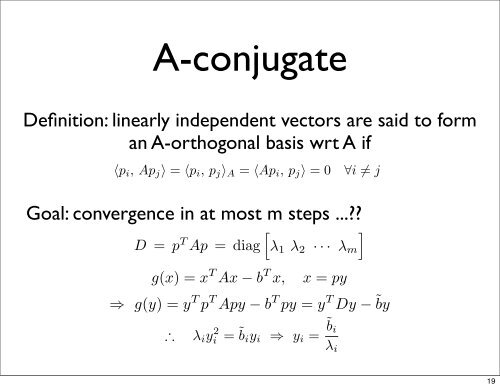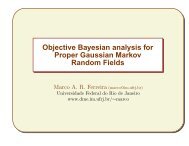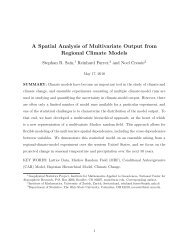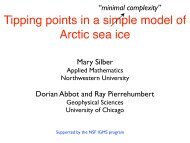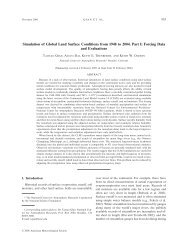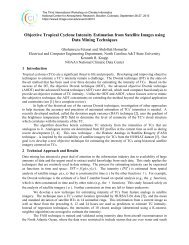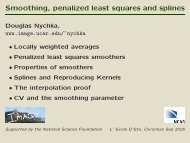Introduction to Krylov subspace methods - IMAGe
Introduction to Krylov subspace methods - IMAGe
Introduction to Krylov subspace methods - IMAGe
Create successful ePaper yourself
Turn your PDF publications into a flip-book with our unique Google optimized e-Paper software.
∴α i = − 〈di , e i 〉 A〈d i , d i 〉 A= − 〈di , Ae i 〉〈d i , Ad i 〉 = 〈di , r i 〉〈Ad i , d i 〉becauseA-conjugate〈x, y〉 A = x T Ay = 〈x, Ay〉 = (Ax) T y = 〈Ax, y〉 for SPD AAe i = A(x i − x) = Ax i − Ax = Ax i − b = −r iDefinition: linearly independent vec<strong>to</strong>rs are said <strong>to</strong> formDef. Linearly independent vec<strong>to</strong>rs (p 1 , p 2 , · · · , p n ) with propertyan A-orthogonal basis wrt A ifRYLOV SUBSPACE METHODSKRYLOV SUBSPACE 〈p i , Ap j 〉 METHODS = 〈p i , p j 〉 A = 〈Ap i , p j 〉 = 0 ∀i ≠ j2LOV SUBSPACE METHODS 25are said <strong>to</strong> form an A-orthogonal basis w.r.t. A.or A Goal: = A convergence in at most m T , we have D = p T ]]steps ...??For A = A Ap T , we have D = p T Ap = diag[λ 1 λ 2 · · · ·] λ m with withD D : :: diagonA atrix, = p := Ap T := , we A-orthogonal have D = column p T Ap vec<strong>to</strong>rs = diagand[λ 1 λ 2 · · · λ m with D : diagonalp := A-orthogonal column vec<strong>to</strong>rs andg(x) = = x x T T Ax − b T x,x = py⇒ ⇒g(x) g(y) g(y) = x= y TT yAx T p T p T − Apy b T x,− b T x py = pyy T Dy − ˜by˜by⇒ g(y) = y T p T Apy − b T py = T Dy − ˜by∴ λ i yi 2 = ˜b i y i ⇒ y i = ˜b ∴∴λλi yi 2 ˜b i i i yi 2 = ˜b i y i ⇒ y i = ˜b i,iλ i ihere λ,re e λ i λ i i are i are eigenvalues of A.eigenvalues of A.19


